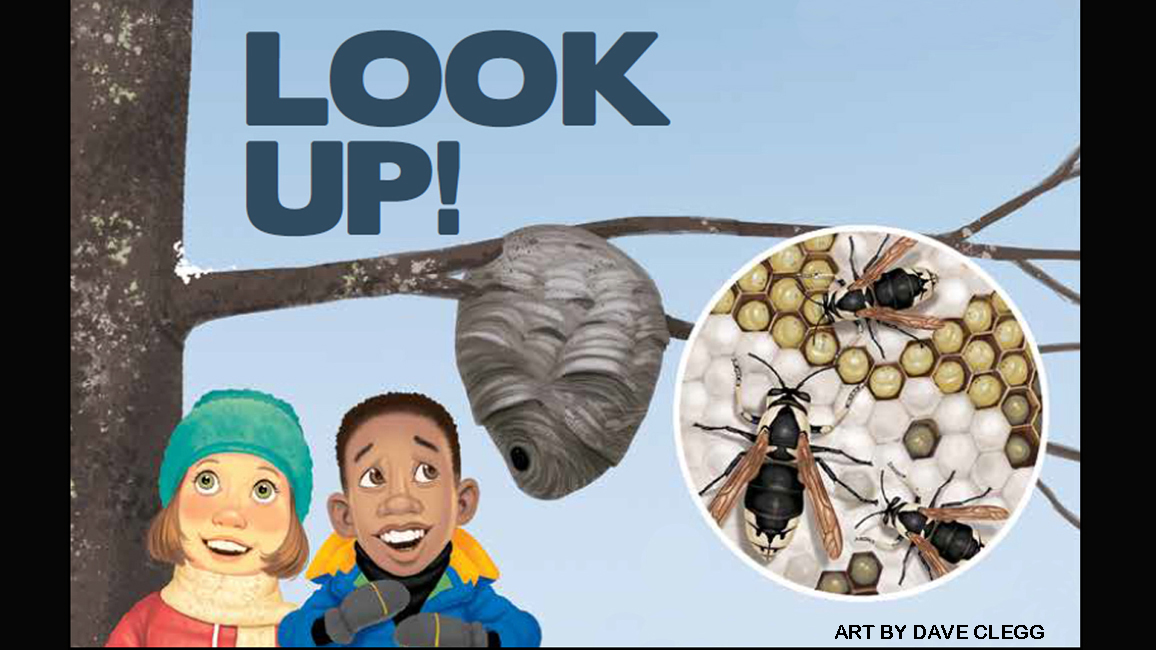
Want to see what animals have been doing all year long? Go on a winter walk and keep your eyes up in the trees!
Many animals are busiest during spring, summer, and fall. That’s when they mate, raise their babies, and eat as much as they can. But often, those activities happen where people can’t see them. They take place in trees and shrubs, behind a “curtain” of leaves.
When the days get shorter and the weather gets colder, many trees and other plants lose their leaves. The curtain disappears, and some very interesting things are revealed! So bundle up, take a walk, and look up! What do you see?
A CLUMP OF LEAVES
This messy bunch of dried leaves and small branches is a drey (DRAY)—a nest where squirrels rest and raise their babies. (Squirrels also make nests in tree holes—especially during colder weather.) The drey may look sloppy to you. But it’s actually a well-made, sturdy home. To build it, a squirrel mom and dad first make a frame out of small branches. Then they layer it with leaves and line it with grass, moss, or other soft stuff. It’s a perfect place to keep their babies safe from bad weather and predators
BOUQUET OF BERRIES
The big, green clusters up in this leafless tree are mistletoe. Mistletoe lives in trees all year round. But it’s easiest to spot when the trees it lives in have lost all their leaves.
Mistletoe has a romantic reputation. Some people think you’re supposed to kiss under it! And certain animals have good reason to love it. Many birds love to eat its berries. And some butterflies, including the great purple hairstreak, lay their eggs only on mistletoe. When the eggs hatch, the caterpillars come out hungry. They munch on the plant as they grow. This clump of leaves makes a great caterpillar nursery!
A “PAPER” BALL
Hanging from this bare tree branch is a gray, striped nest about the size of a football. If it looks like papier mâché, that’s because it is—sort of!
It all started last spring, when a female bald-faced hornet, called a queen, began building a place to lay her eggs. She chewed up wood to make a paste called pulp. Then she used her jaws to form the pulp into layers, which dried to become a “paper” nest. When the nest was large enough, the queen laid some eggs inside it. These hatched into larvae (LAR-vee), or young, that grew up to become workers. The workers helped the queen make the nest larger.
Toward the end of summer, the queen laid eggs that grew into males, called drones, and new queens. By fall, the drones and new queens mated. Then, when the weather turned cold, the whole crew left the nest, and all but the new queens died. So the nests you see now are empty.
A BOUNTY OF BIRD NESTS
Bird parents usually nest in hidden places, where their eggs and young are safest. After the babies grow up, the nests are left behind—all ready for you to find! (But not to take—it’s against the law to remove nests.) Here are a few empty nests you might spot around your neighborhood.
AMERICAN ROBIN
A robin’s nest is about the size of a grownup’s open hand. To make the nest, robin parents weave together twigs and dead grass, and then add mud to keep it sturdy.
AMERICAN GOLDFINCH
Near the top of a shrub or small tree, a goldfinch family left this tight little cup of a nest. It sits where three small branches come together. Mama Goldfinch wove the neat nest out of twigs, then lined it with soft, fluffy milkweed seeds.
AMERICAN CROW
Clever crows build their big twig nests near the tops of trees. Mom and Dad Crow work together, and sometimes they get a little help from their grown-up youngsters from the year before! When the nest is done, it will be the size of a large pizza and lined with cozy stuff such as animal hair and pine needles.
BALTIMORE ORIOLE
The brightly colored Baltimore oriole makes a nest with a one-of-a-kind shape: sort of like a tennis ball inside a sock! If you’re lucky, you may spot this cocoon-like nest hanging from the very end of a branch, high off the ground.



